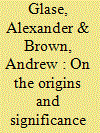| Srl | Item |
| 1 |
ID:
149608


|
|
|
|
|
| Summary/Abstract |
The Plutonium Management and Disposition Agreement between the United States and Russia makes arrangements for the disposal of 34 metric tons of excess weapon-grade plutonium. Under this agreement Russia plans to dispose of its excess stocks by processing the plutonium into fuel for fast breeder reactors. To meet the disposition requirements this fuel would be burned while the fast reactors are run as burners, i.e., without a natural uranium blanket that can be used to breed plutonium surrounding the core. This article discusses the potential application of antineutrino monitoring to the verification of the presence of a breeding blanket. It is found that a 36 kg antineutrino detector, exploiting coherent elastic neutrino-nucleus scattering and made of silicon could determine the presence of a breeding blanket at a liquid sodium cooled fast reactor at the 95 percent confidence level within 90 days.
|
|
|
|
|
|
|
|
|
|
|
|
|
|
|
|
| 2 |
ID:
149609


|
|
|
|
|
| Summary/Abstract |
The International Atomic Energy Agency (IAEA) defines uranium with a 235U isotope concentration of 20 percent as the threshold between low-enriched uranium (LEU) and highly enriched uranium (HEU), and as a significant waypoint on the path towards weapon-grade uranium (typically above 90 percent 235U enrichment). The distinction between LEU and HEU is widely used in shaping nonproliferation policy, and it has featured prominently in commentary over Iran's nuclear program and the series of Nuclear Security Summits that since 2010 have sought to minimize civilian stockpiles and use of HEU. Yet the origin of this threshold is obscure, dating back 6 decades. This research note traces the political origin and the technical basis for this limit.
|
|
|
|
|
|
|
|
|
|
|
|
|
|
|
|
| 3 |
ID:
149607


|
|
|
|
|
| Summary/Abstract |
This preliminary study considers the feasibility of cooling a small nuclear reactor (tens of megawatts thermal) with a well doublet that taps groundwater and injects heated fluid beneath the surface. The associated signatures differ substantially from those of conventional cooling systems. Instead of a plume of steam or outflows of heated water, only wellheads may be observed at a site without access to surface water. Other potential signatures include surface thermal anomalies, geomorphological alterations, induced seismicity, and altered groundwater chemistry. As these signatures may be faint and lag reactor operations, an understanding of the system's operating principles and telltales of hydrogeological conditions conducive to groundwater flow become more critical for detection of such reactor by remote sensing.
|
|
|
|
|
|
|
|
|
|
|
|
|
|
|
|
| 4 |
ID:
149606


|
|
|
|
|
| Summary/Abstract |
Long-standing efforts to develop a commercially viable laser-based process for uranium enrichment, initially with atomic and later molecular isotope separation, have had limited success. This article discusses a model for a third generation of laser enrichment technology where CO2 laser light is Raman scattered to generate 16 μm photons that excite a vibrational mode in uranium-235 hexafluoride molecules within an adiabatically expanding free carrier gas jet, allowing for the partial separation of uranium isotopes by condensation repression. The SILEX (Separation of Isotopes by Laser Excitation) process being developed as part of the Global Laser Enrichment project may be one example of this separation technique. An ideal, asymmetric cascade for enriching uranium to weapon-grade levels is presented, and an analysis of the minimum laser performance requirements is included. Optimal running parameters, physical space constraints, and energy efficiency estimates are discussed. An assessment of the technical skills required is also provided. Finally, material available in an online supplement discusses possible lasers that may be utilized in such a process, and offers an introduction to dimer formation, a laser-based enrichment cascade, and a model for estimating the enrichment factor.
|
|
|
|
|
|
|
|
|
|
|
|
|
|
|
|